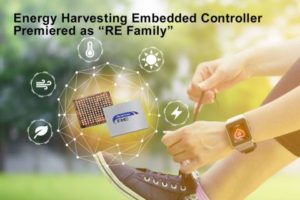 Renesas Electronics Corporation has introduced its RE Family, which encompasses the company’s current and future lineup of energy harvesting embedded controllers. The RE Family is based on Renesas’ proprietary SOTB (Silicon on Thin Buried Oxide) process technology, which dramatically reduces power consumption in both the active and standby states, eliminating the need for battery replacement or recharging.
Renesas Electronics Corporation has introduced its RE Family, which encompasses the company’s current and future lineup of energy harvesting embedded controllers. The RE Family is based on Renesas’ proprietary SOTB (Silicon on Thin Buried Oxide) process technology, which dramatically reduces power consumption in both the active and standby states, eliminating the need for battery replacement or recharging.
Following the mass production of the RE01 Group (formerly known as the R7F0E embedded controllers), the first of the RE Family, the new RE01 Group Evaluation Kit was launched today, which allows users working with the RE01 Group of devices to jump start system evaluations for energy harvesting applications.
The new RE01 Evaluation Kit includes an evaluation board which features an RE01 embedded controller, an interface for the energy harvesting device and a rechargeable battery interface. The Kit also includes an Arduino-compatible interface for easy expansion and evaluation of sensor boards and a Pmod connector to expand and evaluate wireless functionality. In addition, there is an ultra-low power MIP LCD expansion board so that users can evaluate display functions faster.
The Kit also contains sample code and application notes that serve as references for power management design that eliminates the need for battery maintenance, and driver software that supports CMSIS, Arm’s Cortex Microcontroller Software Interface Standard. Sample code for ultra-low power A/D converters, digital filter and FFT (fast Fourier transform) routines, 2D graphics MIP LCD displays, and secure boot and secure firmware update functions for improved security are available. With these features, this kit makes it possible to adopt energy harvesting based on RE01 Group devices at the system level and will accelerate the development of equipment that does not require battery maintenance.
IAR Embedded Workbench for Arm which can use the high-efficiency IAR C/C++ compiler, and e2 studio (note 2) which can use the free GNU compiler are available as the developmental environment.

Leave a Reply